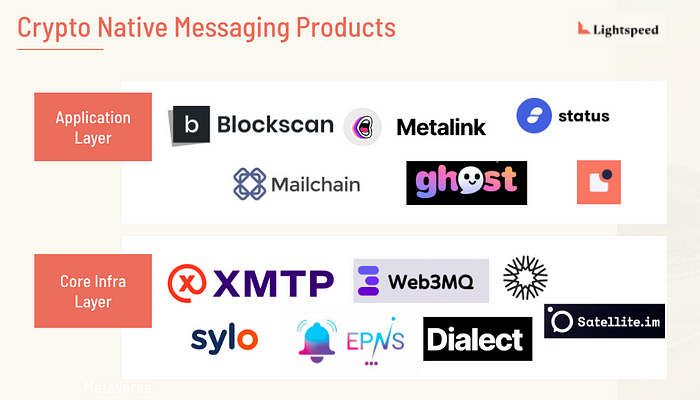Read Part I of the series here, Part III, Part IV.

Crypto’s ‘You’ve got mail’ moment is coming
To steal a line from Mark Twain, the demise of crypto has been greatly exaggerated. Yes, token values are falling, and crypto companies built on the assumption of an ever-rising tide are starting to trim their sails. And yes a “crypto winter” is upon us. But I am confident that crypto’s fundamental underlying technology — blockchain and layered applications — will continue to be a defining technological shift of the next decade.
In my last post I outlined nine major categories of emerging consumer crypto products. Now I’ll dive a bit deeper into what is arguably the consumer product category with the greatest daily use: messaging.
Crypto users want to be able to communicate on-chain in a crypto-native manner, without having to use web2 solutions like Gmail, Telegram, or text messages. A number of motivations are driving the need for this product. Some people want to do this because they feel the security of the web2 platforms is not strong enough. Others simply need the ability to communicate with the buyer or seller of a token or NFT without having to know them personally.
Imagine you find the wallet address that owns the Crypto Coven NFT you’ve been eyeing. You want to contact them to ask if they’d sell, but you don’t know who owns the wallet, and there’s no way to message them. So you go to Crypto Coven’s discord, post a link to the NFT, and hope the owner is in the Discord and sees the message.
Companies are also especially interested in finding a solution. Decentralized apps (dApps) often don’t have much information on their users other than their wallet and purchase history. When dApps want to notify users about an update, they don’t have a way to message them. Decentralized Autonomous Organizations (DAOs) and social crypto communities also have this need. I’m part of several DAOs where organizers who wanted to communicate with NFT-gated customers have needed to share Google Typeforms via Discord channels. And in the end, they resorted to sending Google Calendar invitations as the only way to send formal comms.
Hacking Solutions
To fill the void of on-chain messaging, people are hacking solutions together. One way they’re doing this is through hexadecimal conversion tools, swapping text to hex, and reading UTF-8 inputs as messages on Etherscan. Simple right?
Emerging solutions span application layer chat and core infrastructure
It doesn’t need to be this hard. Thanks to a number of builders in the space, on-chain messaging is getting closer and closer to becoming a seamless messenger replacement. Some of the prominent companies building in the space include solutions at the application and core messaging layer.
Players like Blockscan, Metalink, Ghost, Bunches, Notifi, and more are creating application layer solutions, some in partnership with DAOs and NFT collections, others like Blockscan attached to a massive block scanner.
Others on the infrastructure side are building messaging protocols like ENPS, XMTP, Dialect, Satellite and more to create composable layers that can be adopted by developers. Some like Mailchain span both application layer and infra layer.
Both layers will eventually be needed — in web2 Twilio and WhatsApp are both critical components of messaging experiences, even if you don’t know that you’re using Twilio on a frequent basis.
What’s in your wallet: Discovery, goodbye spam, and polished financial identities
On-chain messaging will fundamentally change social discovery and marketing.
On the social discovery side, you may choose to message someone based on what you can see in their wallet, rather than knowing anything about their geography, aesthetic, career, etc. Consider how we connect today: We reach out to others on LinkedIn based on how attractive their resume is to our own agenda and interests (colleague, sales prospect, title status). We reach out on Instagram because of someone’s aesthetic looks, humor, mutual friends, or the size of their following. We reach out on Twitter because of what a person has written, who else is following them, and so on. In a world where social discovery is based on what’s in someone’s wallet, we will reach out to others based on visible wallet wealth, similar “shopping” or transaction history.
It’s as if we could reach out to others on Amazon based on what they bought, or connect with other Visa credit card holders who shop at similar establishments.
There’s a potentially even bigger opportunity from a marketing perspective. Marketers will be able to reach out to potential customers based on literally what’s in their wallet. And marketers will likely need to pay someone for the privilege of contacting their wallet by sending a token.
But without appropriate spamming moderation, this could get messy. It may lead to consumers deliberately distributing their assets amongst many accounts to avoid being targeted. Consumers already have several wallets for security and mental categorization reasons today like “my YOLO wallet,” “my highly valuable wallet,” etc. But this could spur even greater diversification of wallets, which may then need to be managed by a wallet aggregator rollup.
In a world where a marketer needs to pay you to message your wallet, the implications are enormous for the social and emotional ways in which individuals will carefully craft their wallets to optimize for revenue, privacy, relevance. Polished wallet identities may become the new social media profile.
What founders will need to get right
- Distribution. To really succeed in this space, founders will need to hack distribution to get the consumer flywheel going. No one wants to use a messaging service that their friends and business contacts aren’t using. Messaging is the OG network effects product, the only essential tool many services offer. In the end, it’s both the most used feature and true essence of any social media product. For founders looking to succeed in this space it’s incredibly important to hack the cold start.
- Spam prevention. Email spam rates peaked from 2006 to 2010, when 9 out of every 10 messages was some form of unsolicited commercial email. Today we’re back down to the 30–45% range. A mechanism to ensure wallet holders aren’t continuously spammed will need to be created. Given that we’re already interacting on-chain with linked wallets, a pay-to-play solution might work.
- Social graph. Whether they’re partnering with a decentralized social graph identity layer or building their own, centralized messaging players will try to help us understand whom we may already know and can trust, and whom we cannot. Because centralized social graphs could be exploited, revealing the identity of who owns which addresses, these players will need to pay much greater attention to security.
- Business use cases. As noted above, marketing is a clear use case for on-chain messaging, because it allows for dynamic pricing relative to a wallet holder’s wealth, as well as exceptionally well-targeted advertisements based on wallet holders’ interests. This may also cross into the business world, where a B2B sales outreach is accepted by a wallet holder based on how much someone is willing to spend to get in touch.
- Privacy. Of course, many users will not want to be messaged based on what’s in their wallet. Whether service providers will allow users to opt out of communications altogether is a key question, along with how creative wallet holders will get in trying to mask what’s in their wallet. You could see a world where users have dozens of wallets to hold different crypto assets to make it more difficult for marketers to capture a full picture of their assets and interests.
Other considerations will include whether the solution is peer to peer or client to server, onchain or not, scalability, encryption, identity & verification, and trust & safety (see bottom for more).
The opportunity if a company gets it right
There are ~300 million people holding crypto globally and tens of millions of daily transactions on the blockchain. Compare that to 4 billion plus people who use email globally, 300B emails sent daily globally, and billions of texts sent in the US.
To imagine what’s possible, just look at WhatsApp’s rise to 100B Whatsapp Messages sent daily by 2020.
If a company cracks the code on sending on-chain messages, the potential for the number of messages they could capture is enormous.
Crypto’s You’ve Got Mail moment is coming.
Thanks for reading. A huge thank you to all the founders for your input on this.
Follow me on Twitter and subscribe to my Medium to get the next few installments of this series. Read Part I of the Crypto Native Consumer Products series here.
About Lightspeed
At Lightspeed we’ve been investing in blockchain technology since 2013 and today have 60+ investments, including Solana, Near, Alchemy, Arbitrum, Ripple, FTX, Blockchain, FalconX, Autograph, Royal, Yuga Labs, Audius, and more.
Appendix — more considerations
- Peer to Peer or Client-Server? Which architecture model is better for cost, speed, privacy?
- Application layer or core infrastructure layer? Where will founders spend more time driving value?
- Onchain or not? Do users really want their messages on chain?
- Scalability solution — How do they solve scalability and ensure the solution isn’t too power consumptive?
- Encryption mechanism? How to protect identity and message content?
- Security, phishing — attempts to steal private keys are additional vectors to consider. In web3, at least you can prove who signed and sent you messages.
- Identity and verification — messaging tends to be coupled with identity. Will people adopt a single standard? Will they have multiple identities? How will this be made portable?
- Identity and account security: Messaging is often linked closely to identity. Loss of control of your identity allows someone else to impersonate you. Protecting users from having their credentials compromised is a priority.
- Message layer security: Proving who sent a message is critical to protect users against phishing attacks. How does a project use signatures, sender verified addresses, etc to provide security?
- Accessing messages: How to ensure encrypted messages are safe for long periods of time as cracking codes becomes easier? How to encrypt the location of the message in addition to the metadata?
- Design around composability — Composable pieces around social graphs, data, etc. exist & designing around focused protocols may win due to better technical network effects
- Trust & Safety — while decentralized messaging may make it easier to exercise free speech, it might also make policing extremist language harder — thoughtful design around this will be key
Authors



